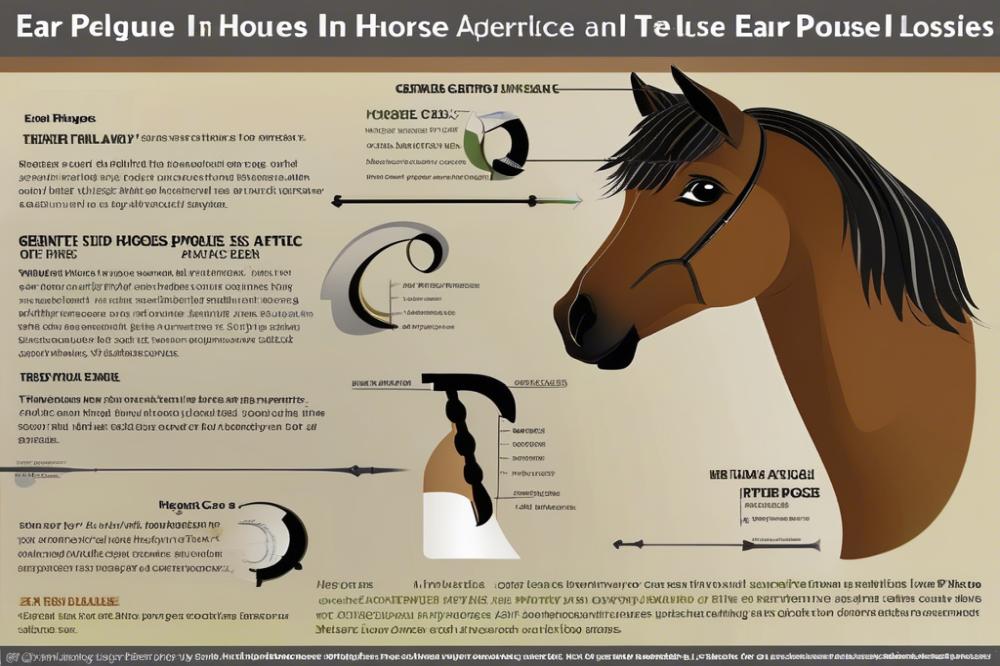Overview of Ear Plaques in Horses
When we think about taking care of horses, many folks picture shiny coats, strong hooves, and maybe even a majestic mane blowing in the wind. However, there’s an often-overlooked topic that deserves some attention: ear plaques. These small, yet notable growths can pop up on our equine friends, and even though they might not be as glamorous as a flowing mane, understanding them is a key part of overall horse health.
Importance of Understanding Ear Plaques

Why should we care about ear plaques? For one, they can indicate underlying equine issues that could affect your horse’s well-being. Picture this: you’re grooming your horse and notice some unusual lumps around the ears. It’s tempting to brush it off, thinking it’s just another quirk of your four-legged buddy. However, ignoring ear issues could lead to bigger problems down the line. Monitoring these plaques not only helps in maintaining excellent ear care but also promotes the horse’s comfort and happiness.
Having a clear grasp of ear plaques prepares horse owners to take prompt action. Remember when your grandma used to say, “A stitch in time saves nine”? Well, the same is true for our horses. Addressing these growths early can lead to better health outcomes and prevent unnecessary discomfort.
Purpose of the Article

This article aims to shed light on ear plaques, starting from what they are to their significance in horse care. We will explore ear plaques treatment options, common causes, and how they can relate to your horse’s overall well-being. Since horses can’t speak up when something isn’t right, it falls on us, their caregivers, to observe and understand these subtle signs. And who knows, by the end of this piece, you might even have a better grasp on how do wild horses maintain their hooves; after all, it’s all connected in the grand scheme of horse care!
So, let’s dive in and get to know these peculiar little growths. Whether you have a retired racehorse lounging in your backyard or you’re in the business of breeding ponies, knowing about ear plaques is an important part of keeping your equine companions happy and healthy.
What are Ear Plaques

Definition of Ear Plaques
Ear plaques refer to small, raised areas of skin found in a horse’s ear. They may not look like much, but they can raise a few eyebrows among equine enthusiasts. These formations are typically benign, meaning they aren’t harmful, but they can be quite a source of curiosity. Understanding what these plaques are is key to maintaining good equine health.
Physical Characteristics
Physically, ear plaques appear as smooth or slightly rough patches. Their coloration can vary, usually appearing light gray or white. On some horses, these plaques may be more prominent than on others. It’s not uncommon for them to change slightly with the seasons as the horse’s skin reacts to environmental factors. Imagine a bit of extra texture—like sandpaper on a perfectly nice piece of wood!
Common Locations in the Ear
When it comes to location, ear plaques are usually found on the outer edge of the ear. You might see them near the base or even further up. They can sometimes appear near the ear canal, which can be a bit tricky. It’s important to keep an eye on where they pop up. Regular ear care is vital, as monitoring these spots can help prevent potential equine issues. After all, keeping our horses healthy is just part of good horse care.
Causes of Ear Plaques
Genetic Factors
Genetic factors can play a big role in the development of ear plaques in horses. Some breeds are just more prone to these issues. If your horse has parents with this condition, there could be a higher chance of developing plaques too. It’s like inheriting your grandmother’s knack for baking cookies. Genetics can sometimes create surprises that aren’t always welcome.
Environmental Influences
Environmental influences contribute to ear plaques as well. Horses exposed to harsh weather or irritants may be more likely to develop these growths. For instance, dust, flies, or even certain plants could irritate their ears. Periods of extreme heat or cold might also play a part. Think about it—if you’re uncomfortable, you’d probably react in some way too!
Health Conditions Linked to Ear Plaques
Several health conditions can create a connection to ear plaques. Skin allergies or infections may lead to abnormal growths in the ear area. Regular check-ups can help catch these issues early. Remember, a horse in good health is like a well-oiled machine! Keeping tabs on their overall condition is critical for managing equine health. Additionally, ear care should not be overlooked, as it plays a key part in avoiding plaques.
Monitoring your horse for any changes can help with early detection. Regular grooming also helps keep an eye on their ears. Let’s not forget, if your horse seems uncomfortable, it’s worth having a vet take a look. They can offer the best advice on ear plaques treatment and help maintain your horse’s comfort and well-being.
Symptoms and Identification
How to Recognize Ear Plaques
It can be tricky to spot ear plaques in horses right away. These growths usually appear as raised, scaly patches on the inside of their ears. They may also have a crusty appearance that can easily go unnoticed at first glance. If you’re giving your horse a good once-over, keep an eye out for any unusual bumps or changes in texture there.
Checking your horse’s ears can become a routine part of horse care. While grooming, run your fingers gently along the ear area. This simple act could reveal something unexpected. Ear plaques often don’t cause pain, but they aren’t something you should just brush off.
Behavioral Signs in Affected Horses
Some horses may show alterations in behavior if they have ear plaques. Affected horses sometimes shake their heads more than usual. This shaking could signal irritation, even if the plaques aren’t painful. Additionally, these horses might shy away from head handling. If you notice your horse being extra sensitive around the ears, that’s a clue worth investigating.
You might also see signs of anxiety. If a horse is experiencing discomfort, it can easily lead to fidgeting or restlessness. It’s like that time you had an itch you couldn’t scratch! Just think of how annoying that is.
Differentiating from Other Ear Conditions
Not all ear issues are the same. Allergies or infections can look similar to ear plaques but often come with extra symptoms. If you spot redness or swelling, that could indicate something more serious. Ear infections might even cause a foul odor, which isn’t typical for ear plaques.
From time to time, other types of growths can pop up as well. These might appear as lumps rather than plaques. Always take some time to observe any changes closely. Keeping track of your horse’s ear health is smart. It can help you differentiate between equine issues effectively.
In the end, knowing how to identify ear plaques is an important piece of the puzzle when it comes to horse health. Regular ear care plays a big role in keeping your horse comfortable and happy.
Diagnosis and Veterinary Care
Veterinary Examination Procedures
A thorough check-up starts with a visit to the vet. During this appointment, the veterinarian will observe the horse’s ears closely. They’ll look for signs of irritation, infection, or, of course, those troublesome ear plaques. The vet may gently handle the ears to check for pain or sensitivity. It’s a bit like visiting the doctor; you want to be comfy but you also have to cooperate.
Tests and Evaluations Used
Sometimes, simple observation is not enough. A vet might take a sample from the ear for further testing. This sample can reveal if bacteria or yeast are involved. In other cases, they might use specialized tools like an otoscope to see deep inside the ear. Doing this helps them diagnose any underlying equine health problems. It’s better to get all the information upfront than to guess.
When to Seek Veterinary Care
If you notice your horse shaking its head constantly, it’s time to act. Unusual behaviors like rubbing its ears against objects can signal trouble. Don’t dismiss excessive scratching or discomfort either. These subtle clues can indicate something isn’t quite right. Early intervention is often the best way to handle equine issues. Veterinarians can provide effective ear plaques treatment that helps restore your horse’s health quickly. Trust your gut—if something seems off, reach out for professional advice. After all, caring for a horse is a serious responsibility, and your buddy deserves the best attention possible.
Treatment and Management
Current Treatment Options Available
Medication is often the first step. Vets may prescribe antifungal or antibiotic treatments. These can help clear up any infections or irritations. Sometimes, topical ointments are also suggested. These can soothe the horse’s ears and encourage healing. Always follow a vet’s advice for dosages and application methods.
Another option might include cleanings. Regular cleaning of the ear area can help prevent issues. Using a soft cloth can be a simple way to keep things tidy. Products specifically designed for ear care in equines are available too. They help to remove dirt and buildup that could lead to more serious problems.
Home Remedies and Care Tips
Home remedies might not be the go-to solution, but they can help! Diluted apple cider vinegar can work wonders. Mix it with water, and apply it gently with a cotton ball. This mixture helps keep ears clean. Not only is it easy to use, but it’s also inexpensive.
Maintaining general hygiene is key in horse care. A clean environment contributes greatly to equine health. Regularly check the horse’s ears when grooming. Early detection of ear plaques or other issues makes a real difference.
Keeping your horse stress-free is equally important. Stress can worsen many equine issues. Create a calm environment during grooming sessions. Play relaxing music or give your horse gentle pats. This simple act can contribute to both ear care and overall well-being.
Preventive Measures
Prevention is always better than cure. Regular check-ups with a veterinarian can catch problems early. Vaccinations also play a vital role in maintaining horse health. Protecting your horse from common ailments helps keep the stress off both you and your equine friend.
Clean stalls and living areas minimize the risk of infections. Flies and other pests love dirty surroundings, which can lead to more serious problems. Setting up fly traps or using repellents can be beneficial. This not only protects the horse’s ears but also enhances their comfort.
Furthermore, a balanced diet supports good immune function. Nutritional supplements may also help improve ear health. Always consult a vet before introducing anything new to your horse’s diet. Remember, being proactive in horse care ultimately saves time and trouble down the road.
Impact on Horse Health and Performance
Potential Complications of Untreated Plaques
Ignoring ear plaques can lead to more serious problems. These growths may cause pain and irritation. When discomfort happens, a horse’s mood can take a nosedive. You might notice your equine friend being grumpier than usual. Who wants to deal with a cranky horse? Over time, those little bumps can lead to infections. Think of ear care as preventive medicine. Keeping up with treatment can save you headaches later.
Effect on Comfort and Behavior
Comfort is key for any horse. Coziness affects how they behave, and that’s a no-brainer. Horses are sensitive creatures. An itchy, uncomfortable ear can turn a happy pony into a difficult diva. Imagine trying to focus on a jump while you have an annoying itch! You might find your horse acting restless or even aggressive. Watching for signs of distress can help you catch issues early. If competition is on the horizon, don’t let ear plaques steal the show.
Long-Term Implications for Performance
Performance is everything in the equestrian world. A horse that feels good performs well. When equine issues arise, that can change fast. Untreated ear plaques might affect balance and coordination. In the long run, this might lead to a drop in athletic ability. Plus, don’t forget about the mental aspect! A distracted horse won’t focus on the job at hand. Investing in horse care and addressing ear plaques treatment is key. A little effort now can lead to big wins down the road.
Wrapping It All Up
Let’s take a moment to recap the key points we’ve covered about ear plaques in horses. These pesky growths, often harmless, can be an annoyance for both the horse and its owner. They typically appear on the upper part of the ear and can sometimes contribute to sensitivity or discomfort. While they are not usually a sign of a serious health issue, recognizing them early is important for effective management.
For every horse owner out there, it’s vital to keep an eye on the ears of your equine buddy. Regular check-ups can help catch any changes early on. The last thing you want is for your horse to be uncomfortable all because you missed spotting those ear plaques. If you notice something unusual or if your horse seems to be shaking its head more than usual, don’t hesitate to consult with a veterinarian. That’s a little nugget of wisdom that can avoid a lot of trouble down the road!
Finally, caring for your horse goes beyond just keeping an eye on the obvious issues. Incorporating activities like horse ground pole exercises can not only keep them fit and engaged but also help you bond with your four-legged friend. It’s like a fun day out at the doomben racecourse dress code—well, minus the fancy attire! Getting involved in your horse’s routine can create a lasting relationship based on trust and mutual respect.
In closing, remember that while ear plaques can be a nuisance, they are often manageable. With a little attention and appropriate care, your horse will remain happy and healthy. Keep riding, keep smiling, and enjoy every moment with your wonderful steed. They’re not just animals; they’re family!



